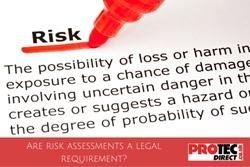Not everything that makes perfect sense is required by law, and not everything that is required by law makes perfect sense. However, there are some occasions when both the law and common sense appear to be in synthesis, and in the area of risk assessments in the workplace, this is absolutely the case.
A risk assessment is the careful examination of the factors that could pose a risk to people who are in a working environment. They allow employers to identify the areas of significant threat, protecting employees and eliminating wasted effort. It’s a working practice that does make perfect sense. Most importantly, it’s also a legal requirement.
Employers have a legal obligation to protect the health and safety of their workforce. Regulation 3 of the Management and Safety at Work Regulations 1999 requires that all employees assess the risks faced by their staff while they are at work. There are a number of specific areas where risk assessments particularly apply.
Manual handling
The Manual handling Operations Regulations from 1992 means employers have to carry out risk assessments on manual handling tasks, with reference to load, capability and working environment. The Health and Safety Executive (HSE) has produced a Manual Handling Assessment Chart in order to facilitate risk assessments in this area.
Upper limbs and RSI
It’s not always obvious what the risks are in a working environment. A heavy load or moving object is a more visible risk, but repetition of small tasks over time can be equally as damaging. The HSE’s Assessment of Repetitive Tasks tool can help you to determine the risks.
DSE
The Display Screen Equipment Regulations act 1992 also requires that employers undertake an analysis of the workstation to assess potential risks to eyesight from screens.
However, risk assessments can apply to any task or activity where there can be a possible danger to staff. This includes tasks such as cleaning - where dangerous substances might be used – maintenance jobs, and the use of any kind of machinery. In many instances, the result of a risk assessment is the use of personal protective equipment (PPE) such as goggles, gloves and hi-visibility workwear in order to maximise safety at work.
The stages of a risk assessment
A good risk assessment will help to reduce the chance of an accident, illness and even save lives. It may increase the cost to the business in the short term, but over time this will be recouped by reduced employee absenteeism, as well as lower insurance costs and compensation claims.
A risk assessment should follow a standardised pattern similar to the below.
• Identify any hazards
• Investigate how this could harm an employee
• Evaluate risks and existing precautions and address additional concerns
• Record your findings and inform staff
• Review the process regularly, when the work changes or an accident occurs
We all have the right to work in a safe environment. The fact risk assessments are a legal requirement means this right is now enshrined in law.





Leave a comment